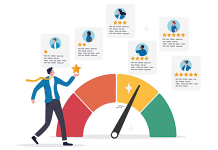Nick Kavadellas is thankful for golf, not only because he’s enjoyed playing it for years, but also because it is one of the few face-to-face selling tools he has continued using during the COVID-19 outbreak. In fact, Kavadellas, CEO of Georgia-based Orasi, a software developer, reseller and consulting firm, was scheduled to play a round with a client and a prospect the day after we spoke with him in November for this story.
But Kavadellas recognizes the golf course doesn’t suit everyone as an effective setting for a sales meeting. Orasi’s team of 12 field sales reps is supplemented with 10 inside salespeople who call on a second tier of prospects. When the field reps were forced to stop calling on customers and prospects in person last March due to the pandemic, the company was faced with a challenge.
“We realized that for the foreseeable future, instead of having 12 field people and 10 inside, we really had 22 inside sales reps. Learning to manage sales virtually versus the way we’d done it historically was going to be a learning curve,” Kavadellas said.
Trends that are here to stay
The shift to less face-to-face interaction with customers and prospects isn’t a 2020 development. Buyers have increasingly embraced completing their own research for years. A Sales Benchmark Index survey from 2017 reported that in nearly 75% of sales situations, customers prefer not to meet in person.
Though many field sales reps are already accustomed to using web meetings or phone calls to navigate some of the sales process, what is new for a large percentage of sellers is 100% reliability on virtual interaction to sell. And there are some industries that still rely on printed catalogs and handshakes to close deals — “knuckle and hand kinds of businesses” as one source we spoke with calls them.
Conventional wisdom holds that even in those industries in which business was mostly conducted face-to-face prior to the pandemic, customers will be reluctant to return to that model in a post-pandemic world. Scott McCartney, who covers air travel for The Wall Street Journal, worked with three airline industry analysts to determine the long-term impact of COVID-19 on business travel. They estimate total air travel could drop between 19% and 36% permanently due to changes in business travel.
The cost savings to businesses is too significant, and the efficiencies from buyers’ perspectives too valuable, thus both sides of the sales equation will likely want to retain the Zoom meeting model for many sales calls.
Scott Galloway, a professor of marketing at NYU’s Stern School of Business, states in his book, “Post Corona: From Crisis to Opportunity,” that the pandemic’s most enduring impact will be as an accelerant of dynamics that were already trending. “Take any trend — social, business or personal — and fast-forward 10 years. Even if your firm isn’t there yet, consumer behavior and the market now rests on the 2030 point on the trend line — positive or negative,” he writes.
What does it mean for B2B sales managers as they strategize for 2021? Is it necessary to train sales reps on new skills? What components of an existing sales process transfer well to virtual interactions? What should sales kickoffs look like? Here are some key points to keep in mind.
Virtual calls require more precise planning and a tighter focus.
Virtual sales conversations, product demos and other virtual customer interactions leave less room for mistakes, says Charles Brennan Jr., president of Brennan Sales Institute and the author of “Take Your Sales to the Next Level.” A fan of Formula 1 racing, Brennan compares a virtual sales call to driving these super-speedy machines (which can exceed 230 mph).
“If you make mistakes virtually, you’re into the wall. You’re not going to get the next opportunity. People shut you down more rapidly,” he says. In-person sales calls, which often stretch to 90 minutes or more over a meal, are more like driving on a four-lane highway with ample room to maneuver. (Read Brennan’s article here.)
“If you don’t have a plan to get someone involved in a higher discussion in a virtual world, things will start to shut down quickly. You have to be intriguing,” Brennan says. Reps on virtual calls must make their added value apparent within the first 15 minutes.
Andres Lares, managing partner at Shapiro Negotiations Institute, agrees that virtual sales calls require more extensive pre-call planning so reps can be on point. However, Lares cautions against jumping right into a sales presentation for fear that time is tight. His company is emphasizing training salespeople to be more succinct, precise and sharp, while also focusing on the personal part of relationships to establish trust.
“The engagement piece is the skill you need to layer on the most,” Lares says. “It’s being willing to spend more time than ever on the person, the personal, the relationship aspect and the business. You can always get to [product features and similar messages] via email. You can send a deck or a proposal, but you want to spend that rich time with video on the relationship-building and building credibility.”
Role play virtual sales interactions.
Reps must practice to get the right rhythm for condensed virtual sales calls. Because virtual calls will be condensed and there will be more of them, it’s wise to role play calls at various stages of the selling process.
“It’s almost like sellers regress in a lot of ways in online meetings,” says Tom Pisello, chief evangelist at Mediafly, a provider of a sales enablement and content management platform. “Sellers will show up and throw up, using a PowerPoint to drive the whole meeting, which they had moved away from in person. Now that they’re online, they feel like they have to fill that blank space with something, so up goes the presentation and out go the lights of the buyer.”
Pisello says it’s important that salespeople understand the unique questions and needs of each person they meet with so they can tailor the call to those points of information. For many companies, that means repackaging their presentation materials for easy access to what matters to the customer.
Role playing can help reps get comfortable with designing each presentation to suit the needs of the individual client, eliminating parts of a presentation and jumping ahead to other parts instantly within each conversation. In October, Mediafly purchased Presentify, a European company that helps brands repackage their sales content for more interactive and engaging presentations.
Use all the tools in your toolbox.
Video interaction with customers and prospects is more precious, which means it should be scheduled judiciously. Yes, virtual selling requires more touches that are shorter in length. However, salespeople need to be conscious of what’s best handled in a Zoom call and what can be delivered via email or a text. If you want to get strong content into your prospect’s hands that supports your value-added message, for example, text a link or send a quick email.
Ensure tech proficiency and use.
Your reps won’t use the tech tools they have if they aren’t properly trained on them. Kavadellas says his focus for training this past year, as his field reps went completely virtual, was to make them more proficient on the Salesforce CRM software his company uses. Orasi’s field reps were not as adept as the inside sales team at using the CRM software, nor had they established the habit of using it.
Kavadellas says some of his inside sales reps led instruction on best practices with the CRM as well as how to convince prospects to agree to a virtual call and how to engage them more quickly on those calls. Orasi also began using a third-party training vendor before the pandemic for training on virtual sales calls.
It’s important that reps are thoroughly comfortable with Zoom, Teams or whatever virtual conference platform you use, not only so they don’t encounter technical delays that steal precious sales call time, but also because they will likely serve as IT support for the customers and prospects who are on their calls.
Reps need to take inventory of their social media connections.
Because salespeople will be spending more time in front of their computers, making the most of virtual interactions will include paying more attention to their social media connections, says Brynne Tillman, CEO of Social Sales Link, a sales training company that focuses on using LinkedIn to boost performance. Dozens of potential sales leads are hiding in plain sight in reps’ LinkedIn connections, she says.
“From current clients, to past clients, to prospects, to referral partners, to centers of influence, to community leaders and coworkers: All of them play a role in sales. If we begin by categorizing our existing connections, when we get to the next step, which is building deeper relationships, we’ll know who we’re going after and what kind of conversation we want to have with each.”
Invest more in marketing content and make sure reps are up to speed on it.
It stands to reason that if customers are relying less on in-person meetings for information, they’re relying more on their own online research. This is certainly not a new trend, but it is also one that is certain to increase. A LinkedIn report states that Demand Gen research shows marketing content has more influence over B2B buying decisions than ever, with 49% of buyers saying they rely more on content to guide their decisions than they did a year ago — and 78% consuming three or more pieces of relevant content before talking to a salesperson. Blogs, webinars and podcasts are among the most influential content, according to the Demand Gen survey.
“More than three quarters (78%) of buyers say they are placing more emphasis on the trustworthiness of a content’s source than they did a year ago, and 65% say they are consciously focusing more on credible content from industry influencers,” the report states. “The barriers to entry for B2B content are going up, but so too are the rewards when you signal value and credibility in the right way. Choosing the right formats for different stages of the buying journey is a big help.”
Monitor your reps’ well-being.
It’s not all about technical proficiency and improving virtual sales call skills. Your reps need to feel good physically and mentally to perform well. As we noted in a previous focus report, the wear and tear of COVID-19 and what will be more than a year of working from home can be taxing on salespeople who are often highly social beings.
Charlie McCarter, vice president of global client delivery at ServiceSource, a market leader in outsource sales services, told us that while his team of salespeople have always sold virtually, they miss the energy of a sales floor and the support of physically working together.
“Without being face-to-face and feeling what we would refer to as a very audible buzz on the floor, our leaders have to be much more adept at paying attention to their teams, staying engaged, making sure there are frequent check-ins and not assuming that every one of their team members is having the same experience. That has been the biggest shift in learning for us. Everyone’s family situation is different from their professional situation and those worlds have collided,” McCarter says. “It has become paramount that frontline leaders are engaged and paying attention to their employees’ signals the same way we expect our employees to pay attention to end-user buying signals or relationship signals.
Adapting is not an option
The accelerant that is COVID-19 means B2B sales will increasingly be customer-driven and reliant on digital-first communication. Gartner expects that by 2025, 80% of B2B sales interactions between buyers and suppliers will occur through digital channels.
“As customers increasingly learn and buy digitally, sales reps become just one of many possible sales channels. Because of this, sales organizations must be able to sell to customers everywhere the customer expects to engage, interact and transact with suppliers,” says Cristina Gomez, managing vice president of Gartner.
For B2B sales and marketing professionals, the shift means making transitions that may have already been initiated happen quicker. The trends and predictions you’ve been reading about are here. A comprehensive content marketing strategy is a must. Training salespeople on cutting-edge digital sales skills should be a priority. Engaging customers and prospects where they want, when they want is mandatory.
“If a salesperson was average in person, they’re going to be worse virtually,” Jeni Wehrmeyer, chief operating officer and chief marketing officer of Anthony Cole Training Group, told us. It’s a frightening thought, but one that sales managers must take to heart. Every sales team has middle performers, and 2020 was challenging enough. Companies can ill afford to let performance slide in the year ahead.





